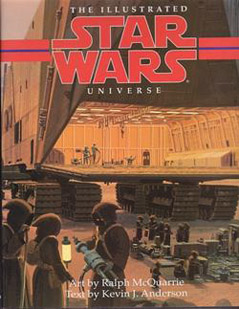Even though he died in 2012, it seems Ralph McQuarrie’s influence will be felt on the 2014 animated series “Rebels” more so than on any “Star Wars” project since the original trilogy. Artists on the show are purposely adding brushstrokes to the work to give it a very McQuarrie feel, which is appropriate since it will take place just before “A New Hope.”
While McQuarrie’s influence was certainly felt throughout the prequels — and some of his old, mothballed character designs were repurposed for “The Clone Wars” — “Rebels” will mark a notable resurgence in his style of art. McQuarrie expert Paul Bateman is keeping the legend alive as well, as he has been making full paintings for Star Wars Insider based on McQuarrie projects that had stopped at the sketching stage.
But for those classic Original Trilogy paintings straight from the man himself, the definitive book is perhaps “The Illustrated Star Wars Universe” (1995). Author Kevin J. Anderson has a blast writing from the perspectives of surveyors of the eight key planets of the O.T. — the six that we actually visit, plus the late, lamented Alderaan and the capital planet Coruscant, which was in early drafts of “Return of the Jedi” and, as such, was envisioned by McQuarrie. (Coruscant was first named in 1991’s “Heir to the Empire” and first visualized in a story in 1991’s “Dark Empire,” then finally seen on screen in 1997’s “Jedi” Special Edition and 1999’s “The Phantom Menace.”)
Although the book is worth having just for the McQuarrie paintings — some of which are new just for this book, particularly the Alderaan art, since those weren’t needed for the films — I recently read Anderson’s in-universe prose (for the first time, I think) to see how the chapters hold up after nearly two more decades of “Star Wars” lore has been added. (For a more technical look at many more “Star Wars” worlds, we have 1998’s “Essential Guide to Planets and Moons” and 2009’s “Essential Atlas.”)
Here are my rankings of the eight chapters:
1. Endor — Perhaps I am ranking this No. 1 because I’m currently on an “Ewoks” movie and cartoon kick, but I also find the curmudgeonly perspective of Imperial Sergeant Pfibee Jhorn amusing. Clearly, he wishes he were on another assignment as he catalogues this moon rich with fauna. Anderson — whose nonfiction writings on the GFFA show biases against some work — strikes a nice balance here. He references the Ewok movies (and we see Joe Johnston art, since McQuarrie didn’t work on those), including the Gorax and the marauders. (This marks the first reference to Charal being a Witch of Dathomir, as the author cleverly ties “Battle for Endor” together with “The Courtship of Princess Leia.”) Meanwhile, I don’t blame Anderson for snubbing the TV show, as — for better or worse — it is mostly too cartoony to fit with this book.

2. Dagobah — This almost reads like a horror story in the vein of “The Ruins” as the planet that Yoda would later tame (to some degree) slowly kills an Old Republic research team that the government had forgotten about. (It was preoccupied with the Clone Wars.) The neatest of Haika Four-Den’s findings are that the gnarl tree-caves (like the one Luke wanders into) start off as mobile creatures before they plant themselves into the ground. I also love the different perspective of seeing the planet from above the trees; what lurks below is a world with no civilization but a frightening abundance of life.
3. Coruscant — Anderson achieves dry comedy here as he writes from the perspective of Pollux Hax, an Imperial propagandist. This chapter holds up quite well considering that the underlevels of Coruscant hadn’t yet been explored in-depth at this point. Anderson himself would venture to the underlevels in his “Young Jedi Knights” books and show the construction process in “Jedi Search.” It would’ve been interesting to learn more about the history of the older layers of city, though.
4. Tatooine — Anderson invents an anthropologist named Hoole who has the alien ability to make his subjects not realize he is there studying them. As such, we get rare, detailed looks at the mysterious Jawa and Tusken Raider cultures, including the latter’s oral storytelling tradition where one missed word means death; Luke also discovered this in “Darksaber.” One thing that doesn’t hold up is the notion that male and female Tuskens dress alike; we’d later see that female Raiders dress differently in “Attack of the Clones.”
5. Bespin — It’s interesting to find out that there was another major city besides Cloud City (the ghost town of Tibannopolis) and to learn the details of the gas-mining process. One missed opportunity here is the lack of mention of the Ugnaughts’ floating city (officially known as the Ugnaught Surface), which was introduced in the Marvel comics as being on the planet’s crust, then retconned to be a floating city since gas giants don’t have habitable surfaces. Interestingly, though, McQuarrie does paint floating rafts of stable algae in what I believe is a new commission for this book.
6. Alderaan — Since we never saw Alderaan on film except as blue-green orb, I kind of imagine it as being a GFFA stand-in for Earth. The EU has shown us that’s not entirely accurate; it’s more like an idealized Earth, filled with peaceful humans who respect the long-dead Killiks (explored a bit more in some of Troy Dennings’ novels), who lived on the planet before they did and left some impressive structures. Of particular note in this chapter are the underground cities built into natural formations, a design that “Revenge of the Sith” would revisit with Utapau.
7. Hoth — The 1993 painting on pages 98-99 of Imperial walkers marching through a field of natural ice sculptures is breathtaking. It’s one of many examples where McQuarrie’s work actually takes my imagination beyond the films, making me realize the shortcomings of movies compared to a painting. Although Anderson awkwardly has his Rebel Alliance narrator tell a wampa horror story similar to what Luke and Callista encounter in “Darksaber,” he mostly portrays Hoth as a big ball of ice. The chapter could’ve benefitted from the author venturing into the grottoes introduced in the Goodwin/Williamson newspaper strips.
8. Yavin 4 — I love the idea of exploring this moon, as Jedi students do in many of Anderson’s novels. A Sullustan naturalist visits Exar Kun’s temple and notes traits such as the barely submerged stepping stones that Michael Stackpole would incorporate into “I, Jedi.” But Dr’uun Unnh only briefly speculates on the nature of the Massassi people; this is a missed opportunity to spell out the aliens’ convoluted history as touched upon in the “Dark Lords of the Sith” comics. Also, the Night Beast story and the apparent destruction of the Great Temple in the newspaper strips could’ve greatly enriched this chapter.
Although it would mostly feature the prequel designers’ work rather than McQuarrie’s, hopefully someday we can get a sequel to “The Illustrated Star Wars Universe” that focuses on the major new worlds from the prequel era.

